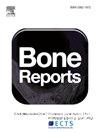p75NTR regulates postnatal skeletal development via NGF-responsive JNK signaling
IF 2.6
Q3 ENDOCRINOLOGY & METABOLISM
引用次数: 0
Abstract
p75NTR has emerged as a key regulator of skeletal development and bone homeostasis. To define its role, we characterized skeletal phenotypes in global and mesenchyme-specific p75NTR knockout mouse models. Global deletion of p75NTR resulted in postnatal growth retardation, decreased trabecular and cortical bone mass, and impaired growth plate architecture—hallmarks of an osteoporotic phenotype that persisted into adulthood. Conditional deletion of p75NTR in mesenchymal progenitor cells using Prx1-Cre recapitulated these skeletal deficits, confirming a cell-autonomous role in bone development. In vitro, bone marrow stromal cells (BMSCs) derived from p75NTR-deficient mouse exhibited diminished osteogenic differentiation capacity, reduced mineralization, and downregulation of key osteogenic genes. Transcriptomic profiling revealed significant suppression of the NGF-MAPK/AP-1 signaling axis in p75NTR-deficient BMSCs. Functional studies demonstrated that loss of p75NTR reduced JNK pathway activation and downstream epigenetic regulators, including Kdm4b and its target gene Dlx5. Overexpression of Kdm4b rescued mineralization defects and restored osteogenic gene expression in p75NTR-deficient BMSCs, establishing a mechanistic link between p75NTR signaling and osteoblast differentiation. These findings define the NGF–p75NTR–JNK–KDM4B–Dlx5 axis as a central regulatory pathway in postnatal bone growth and osteogenesis. Given the critical role of p75NTR in skeletal development and bone homeostasis, targeted modulation of this signaling cascade may represent a promising therapeutic approach for treating osteoporosis and other bone disorders.
p75NTR通过ngf响应的JNK信号调控出生后骨骼发育
p75NTR已成为骨骼发育和骨骼稳态的关键调节因子。为了确定其作用,我们在p75NTR基因敲除小鼠模型中对骨骼表型进行了表征。p75NTR的整体缺失导致出生后生长迟缓,小梁和皮质骨量减少,生长板结构受损-骨质疏松症表型的标志持续到成年期。使用Prx1-Cre在间充质祖细胞中条件删除p75NTR再现了这些骨骼缺陷,证实了细胞在骨骼发育中的自主作用。在体外,来自p75ntr缺陷小鼠的骨髓基质细胞(BMSCs)表现出成骨分化能力减弱、矿化减少和关键成骨基因下调的现象。转录组学分析显示,在p75ntr缺失的骨髓间充质干细胞中,NGF-MAPK/AP-1信号轴受到显著抑制。功能研究表明,p75NTR的缺失降低了JNK通路的激活和下游表观遗传调控因子,包括Kdm4b及其靶基因Dlx5。在p75NTR缺失的骨髓间充质干细胞中,过表达Kdm4b可修复矿化缺陷并恢复成骨基因表达,从而在p75NTR信号传导与成骨细胞分化之间建立起机制联系。这些发现确定了NGF-p75NTR-JNK-KDM4B-Dlx5轴是出生后骨生长和成骨的中心调控途径。鉴于p75NTR在骨骼发育和骨稳态中的关键作用,靶向调节这一信号级联可能是治疗骨质疏松症和其他骨骼疾病的一种有希望的治疗方法。
本文章由计算机程序翻译,如有差异,请以英文原文为准。
求助全文
约1分钟内获得全文
求助全文
来源期刊

Bone Reports
Medicine-Orthopedics and Sports Medicine
CiteScore
4.30
自引率
4.00%
发文量
444
审稿时长
57 days
期刊介绍:
Bone Reports is an interdisciplinary forum for the rapid publication of Original Research Articles and Case Reports across basic, translational and clinical aspects of bone and mineral metabolism. The journal publishes papers that are scientifically sound, with the peer review process focused principally on verifying sound methodologies, and correct data analysis and interpretation. We welcome studies either replicating or failing to replicate a previous study, and null findings. We fulfil a critical and current need to enhance research by publishing reproducibility studies and null findings.
 求助内容:
求助内容: 应助结果提醒方式:
应助结果提醒方式:


